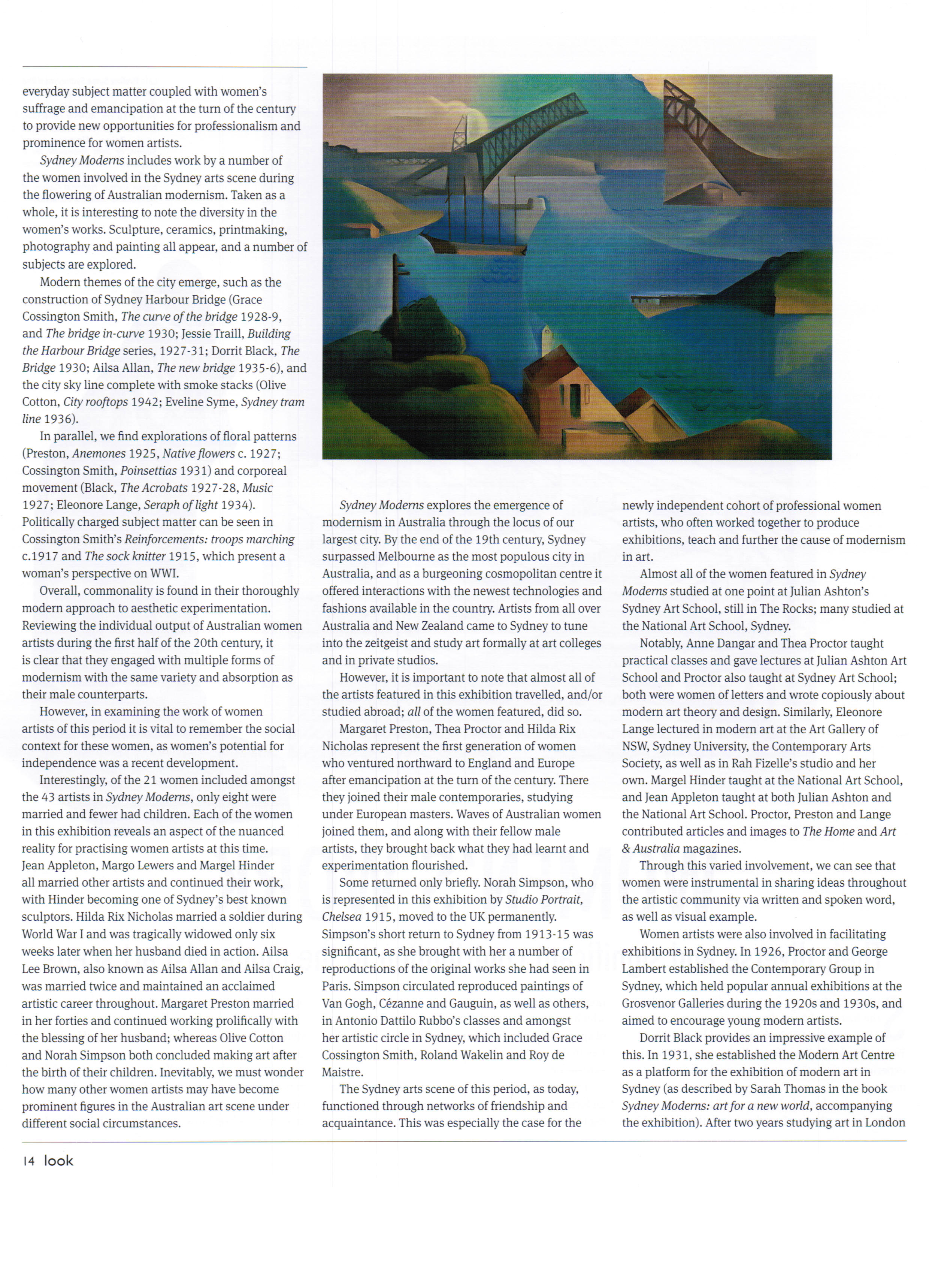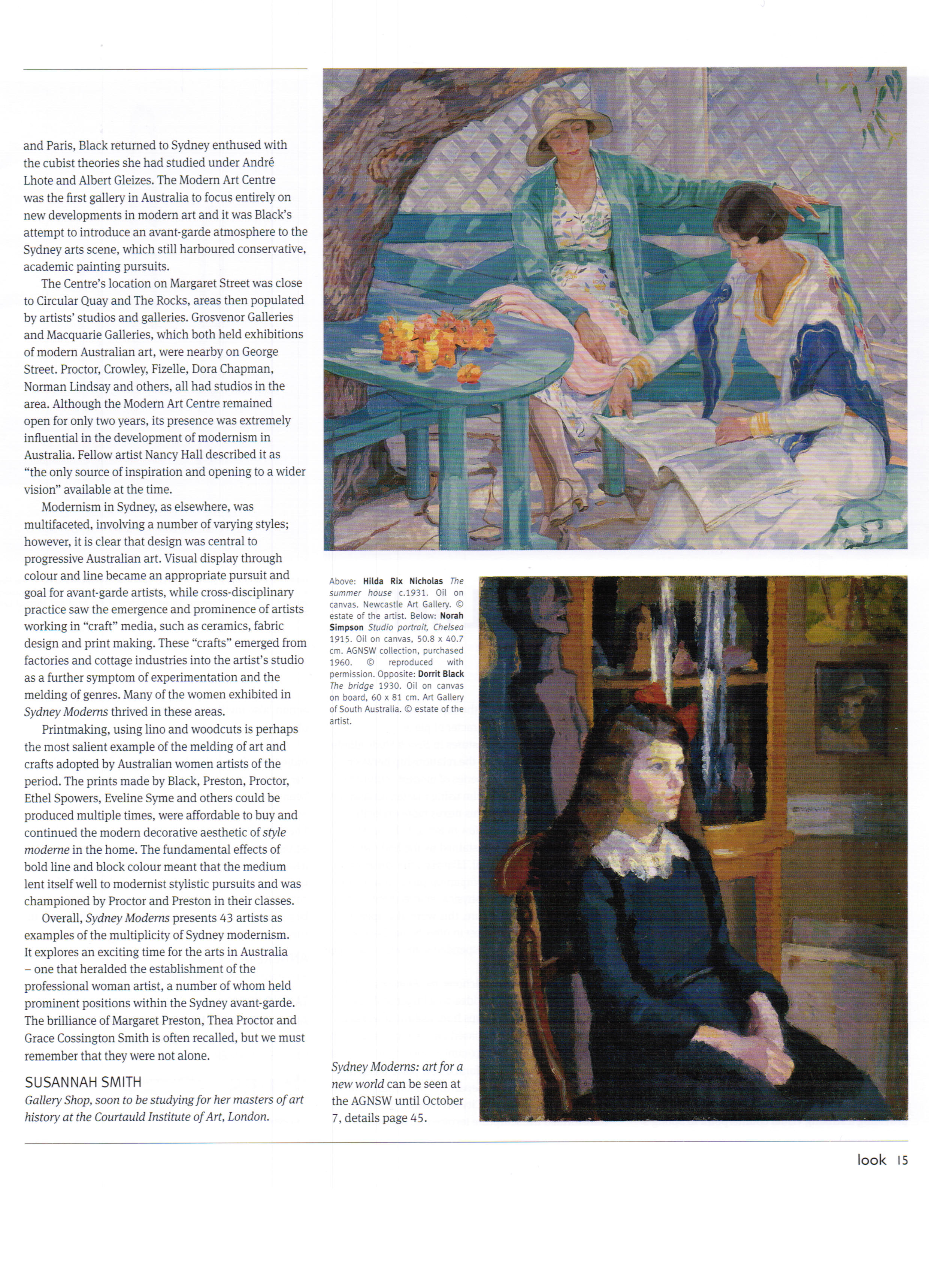Women's Work: the Women of 'Sydney Moderns'
Sydney Moderns explores a significant period in the history of Australian art. The years between 1914 and the 1940s, bookended by the two World Wars, were fertile times for stylistic innovation and experimentation with previously neglected artistic media.
Modernism heralded pattern and abstraction, and in the overthrow of academicism, the long-held hierarchy of genres was reversed. Decorative works which explored line, light, colour and representations of space and movement (such as still life) came to the fore in the avant-garde pursuit of a new language of expression.
For Australian women artists, the modernist focus on formal and “decorative” elements, as well as the exploration of previously lowly subject matter, offered opportunities to excel in areas which had once been viewed as feminine and artistically inferior. These stylistic elements now became the focus of both genders.
As art historian Helen Topliss outlined in 1996 in her groundbreaking study Modernism and Feminism: Australian Women Artists 1900-1949, modernism’s high brow reassessment of detail and everyday subject matter coupled with women’s suffrage and emancipation at the turn of the century to provide new opportunities for professionalism and prominence for women artists.
Sydney Moderns includes work by a number of the women involved in the Sydney arts scene during the flowering of Australian modernism. Taken as a whole, it is interesting to note the diversity in the women’s works. Sculpture, ceramics, printmaking, photography and painting all appear, and a number of subjects are explored.
Modern themes of the city, such as the construction of Sydney Harbour Bridge (Grace Cossington Smith, The Curve of the Bridge, 1928-9, and The Bridge in Curve, 1930; Jessie Traill, Building the Harbour Bridge series, 1927-31; Dorrit Black, The Bridge, 1930; Alissa Lee Brown, The new bridge, 1935-6) and the city sky line complete with smoke stacks appear (Olive Cotton, City rooftops, 1942; Eveline Syme, Sydney tram line, 1936).
In parallel, we find explorations of floral pattern (Preston, Anemones, 1925, Native Flowers, c. 1927; Cossington Smith, Poinsettias, 1931) and corporeal movement (Black, The Acrobats, 1927-28, Music, 1927; Eleonore Lange, Seraph of Light, 1934). Politically charged subject matter can be seen in Cossington Smith’s Reinforcements: troops marching c.1917 and The sock knitter 1915, which present a woman’s perspective on WWI.
Overall, commonality is found in their thoroughly modern approach to aesthetic experimentation. Reviewing the individual output of Australian women artists during the first half of the 20th-century, it is clear that they engaged with multiple forms of modernism with the same variety and absorption as their male counterparts.
However, in examining the work of women artists of this period it is vital to remember the social context for these women, as women’s potential for independence was a recent development.
Interestingly, of the 21 women included amongst the 43 Sydney Moderns, only eight were married and fewer had children. Each of the women in this exhibition reveals an aspect of the nuanced reality for practising women artists at this time. Jean Appleton, Margo Lewers and Margel Hinder all married other artists and continued their work, with Hinder becoming one of Sydney’s best known sculptors. Hilda Rix Nicholas married a soldier during World War I and was tragically widowed only six weeks later when her husband died in action. Alisa Lee Brown, also known as Alisa Allan and Alisa Craig, was married twice and maintained an acclaimed artistic career throughout. Margaret Preston married in her forties and continued working prolifically with the blessing of her husband; whereas Olive Cotton and Norah Simpson both concluded making art after the birth of their children. Inevitably, we must wonder how many other women artists may have become prominent figures in the Australian art scene under different social circumstances.
Sydney Moderns explores the emergence of modernism in Australia through the locus of our largest city. By the end of the 19th-century, Sydney surpassed Melbourne as the most populous city in Australia, and as a burgeoning cosmopolitan centre it offered interactions with the newest technologies and fashions available in the country. Artists from all over Australia and New Zealand came to Sydney to tune into the zeitgeist and study art formally at art collages and in private studios.
However, it is important to note that almost all of the artists featured in this exhibition travelled, and or studied abroad; all of the women featured, did so.
Margaret Preston, Thea Proctor and Hilda Rix Nicholas represent the first generation of women who ventured northward to England and Europe after emancipation at the turn of the century. There they joined their male contemporaries, studying under European masters. Waves of Australian women joined them, and along with their fellow male artists, they brought back what they had learnt and experimentation flourished.
Some returned only briefly. Norah Simpson, who is represented in this exhibition by a single work, Studio Portrait, Chelsea 1915, moved to the UK permanently. Simpson’s short return to Sydney from 1913-15 was significant, as she brought with her a number of reproductions of the original works she had seen in Paris. Simpson circulated reproduced paintings of the modern masters Van Gogh, Cézanne and Gauguin, as well as others, in Antonio Dattilo-Rubbo’s classes and amongst her artistic circle in Sydney, which included Grace Cossington Smith, Roland Wakelin and Roy de Maistre.
The Sydney arts scene of this period, as today, functioned through networks of friendship and acquaintance. This was especially the case for the newly independent cohort of professional women artists, who often worked together to produce exhibitions, teach and further the cause of modernism in art.
Almost all of the women featured in Sydney Moderns studied at one point at the Julian Ashton Art School, still in the Rocks; many studied at the National Art School, Sydney.
Notably, Anne Dangar and Thea Proctor both took their own practical classes and lectures at Julian Ashton Art School and Proctor also taught at Sydney Art School; both were women of letters and wrote copiously about modern art theory and design. Similarly, Eleonore Lange lectured in modern art at the Art Gallery of NSW, Sydney University, the Contemporary Arts Society, as well as in Rah Fizelle’s studio and her own. Margel Hinder taught at the National Art School, and Jean Appleton taught at both Julian Ashton and the National Art School. Proctor, Preston and Lange contributed articles and images to Home and Art & Australia magazines.
Through this varied involvement, we can see that women were instrumental in sharing ideas throughout the artistic community via written and spoken word, as well as visual example.
Women artists were also involved in facilitating exhibitions in Sydney. In 1926, Proctor and George Lambert established the Contemporary Group in Sydney, which held popular annual exhibitions at the Grosvenor Galleries during the 1920s and 1930s, and aimed to encourage young modern artists.
Dorrit Black provides an impressive example of this. In 1931, she established the Modern Art Centre as a platform for the exhibition of modern art in Sydney (as described by Sarah Thomas in the book Sydney Moderns: art for a new world, accompanying the exhibition). After two years studying art in London and Paris, Black returned to Sydney enthused with the Cubist theories she had studied under André Lhote and Albert Gleizes. The Modern Art Centre was the first galley in Australia to focus entirely on new developments in modern art and it was Black’s attempt to introduce an avant-garde atmosphere to the Sydney arts scene, which still harboured conservative, academic painting pursuits.
The Centre’s location on Margaret Street was close to Circular Quay and the Rocks, areas then populated by artists’ studios and galleries. Grosvenor Galleries and Macquarie Galleries, which both held exhibitions of modern Australian art, were nearby on George Street. Proctor, Crowley, Fizelle, Dora Chapman, Norman Lindsay and others, all had studios in the area. Although the Modern Art Centre remained open for only two years its presence was extremely influential in the development of modernism in Australia. Fellow artist Nancy Hall described it as "the only source of inspiration and opening to a wider vision" available at the time.
Modernism in Sydney, as elsewhere, was multifaceted, involving a number of varying styles; however, it is clear that design, more than anything else, was central to progressive Australian art. Visual display through colour and line became an appropriate pursuit and goal for avant-garde artists, while cross-disciplinary practice saw the emergence and prominence of artists working in “craft” media, such as ceramics, fabric design and print making. These “crafts” emerged from factories and cottage industries into the artist’s studio as a further symptom of experimentation and the melding of genres. Many of the women exhibited in Sydney Moderns thrived in these areas.
Printmaking, using lino and wood cuts is perhaps the most salient example of the melding of art and crafts adopted by Australian women artists of the period. The prints made by Black, Preston, Proctor, Ethel Spowers, Eveline Syme and others could be produced multiple times, were affordable to buy and continued the modern decorative aesthetic of style moderne in the home. The fundamental effects of bold line and block colour meant that the medium lent itself well to modernist stylistic pursuits and was championed by Proctor and Preston in their classes.
Surveying the women represented in Sydney Moderns it is clear that the exhibition is not intended to be a comprehensive vision of all of the modernist experiments happening in Sydney at the time. That project would be vast and so multi-faceted that all of the rooms in the gallery would be filled with modernist works.
Overall, Sydney Moderns presents 43 artists as examples of the multiplicity of Sydney modernism. It explores an exciting time for the arts in Australia - one that heralded the establishment of the professional woman artist, a number of whom held prominent positions within the Sydney avant-garde. The brilliance of Margaret Preston, Thea Proctor and Grace Cossington-Smith is often recalled, but we must remember that they were not alone.


